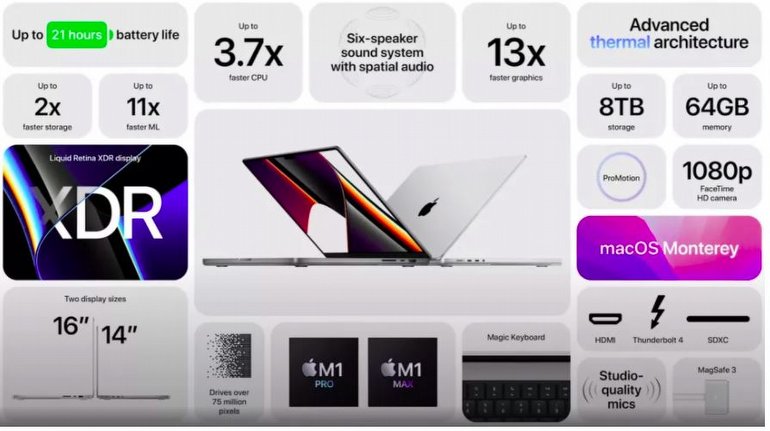Apple has finally announced the new Apple M1 Pro processor, which until now was thought to be the Apple M1X. The company says it’s the first time a SoC design has been created for a professional-grade laptop, making its claim. Better still, this M1 model is accompanied by an M1 Max.
The chip offers up to 32GB of combined RAM and incredibly fast memory bandwidth and can be predicted to be extremely powerful, especially when combined with the 10-core design.
These new chips will be released soon, together with the new MacBook Pro models introduced today, but it is not certain which models will meet us next. Apple says that the Apple M1 Pro, along with the more powerful Apple M1 Max, will be the most powerful chips for professional laptops, and although they have not yet been tested by users, we can say that they seem to be able to support this claim for now.
It was thought that Apple would only release a single pro-level M1 processor under the M1X name. However, the company announced both the Apple M1 Pro and the Apple M1 Max together.
The first laptops Apple announced with these processors were the new MacBook Pro models. Two MacBook Pro devices (14 and 16 inch) with these new chips are now available to order.

The Apple M1 was an extremely successful processor and could deliver high performance without consuming too much power. This meant it provided incredible battery life. It looks like Apple is trying to bring the same design idea to the 16-inch MacBook Pro.
The Apple M1 Pro is a 10-core chip. But even though it’s just two more cores than the original Apple M1, the high-performance core count has doubled. M1 Pro has 8 high performance cores and 2 efficiency cores compared to 4 high performance cores and 4 efficiency cores in the original chip. This rate change also means that the M1 Pro will be much faster than the M1, but with this performance increase, there may be a decrease in battery life.
However, as Apple claims that there will be 70% better CPU performance, creative professionals are sure to not complain about this drop.
The GPU is also getting a major update. The Apple M1 Pro has 2,048 EUs, which is a huge increase over the 128EU (Operating Unit) found in the original M1. But because Apple has focused so much on power efficiency, they’ve apparently only managed to pack in a GPU that peaks at around 30W, but is much faster than what you’d find in integrated GPUs you’d find in an Intel processor. . .
On the other hand, the Apple M1 Max will have a much more powerful GPU. It will contain 32 cores, which means you have 4,096 EUs. However, it’s a little harder to figure out exactly what the features will look like. We’re pretty sure it will be clocked much higher, as Apple’s own graphics show it will use up to 50W of power, but achieve almost the same level of performance as the top-of-the-line laptop graphics in an MSI GE76 Raider. We’re not sure exactly which GPU Apple is comparing here, but this might be the Nvidia GeForce RTX 3080 – and considering that the GPU Apple references apparently uses up to 180W of power – the Apple M1 Max could be the chip for creative professionals who travel vote.
There’s also room for more memory than the Apple M1, which is a good improvement – currently you can only get up to 16GB of RAM on the M1. For most casual users this is fine, but creative professionals need a lot more memory. Fortunately, the M1 Pro will support up to 32GB of combined memory and the M1 Max will support up to 64GB.
More memory is only half the story. . . Apple has also increased the memory bandwidth a lot. The new M1 Pro has memory bandwidth of up to 200GB/s, another key feature for creative users.
The M1 Max, on the other hand, uses the extra space for a second memory controller, which apparently doubles the memory bandwidth, and this processor can offer bandwidth up to 400 GB/s. It seems like a minor improvement, but when editing high resolution video or large projects in Blender, this added memory bandwidth will help your GPU load information faster and reduce project times considerably.